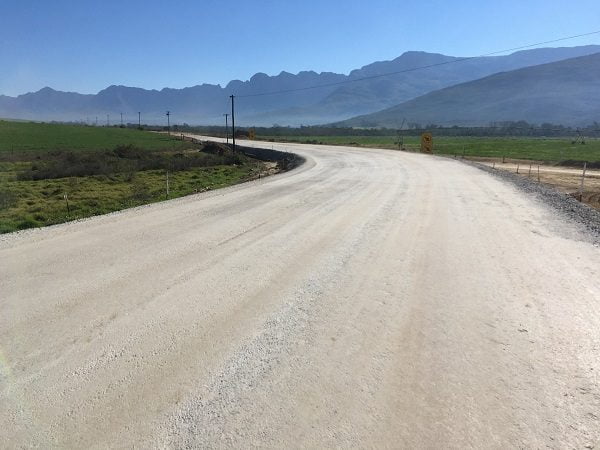 The upgrade of 48 km section of the N2 highway between Caledon and Riviersonderend in the Western Cape is being overseen by JG Afrika. Importantly, the project is being used as a fertile training ground for many local small, medium and micro enterprises (SMMEs) in line with the South African National Road Agency Limited’s (SANRAL) “Fourteen Point Plan.”
The upgrade of 48 km section of the N2 highway between Caledon and Riviersonderend in the Western Cape is being overseen by JG Afrika. Importantly, the project is being used as a fertile training ground for many local small, medium and micro enterprises (SMMEs) in line with the South African National Road Agency Limited’s (SANRAL) “Fourteen Point Plan.”
This scenic stretch of road forms part of the busy route connecting Cape Town with many towns along the southern Cape coastline and further eastward (the route carries around 3500 card and 500 trucks every day).
Duncan Murphy, a technical director with JG Afrika, has been involved in the project since December 2014 when we were initially appointed to undertake the design, and he leads the team of engineers overseeing the construction programme.
As many as 11 SMMEs are being trained by the main contractor, Group Five, which mobilised to site to commence working on the 36 month construction project in September 2017.
Murphy says that the lion’s share of the work scope entails widening the road, as well as upgrading its intersections to better accommodate the increase in traffic over the years and raise safety levels for road users.
“The road, which was built between 1978 and 1983, mainly comprised a single carriageway with surfaced lanes and shoulders. Its surface width varied between 11,5 m and 17,5 m, except for the first 1,12 km, which consisted of four lanes with a raised median island in areas. Once we have completed the project, it will have a minimum surface width of 13,4 m, including two 3,7 m-wide lanes and three metre-wide shoulders, in areas. Where there are existing climbing lanes, the road is being widened to allow for 3,7 m-wide passing and 3,7 m-wide climbing lanes, as well as a 1,5 m-wide surfaced shoulder. Some of the existing climbing lanes are being extended and we are constructing new climbing lanes,” he says.
A 50 mm medium-continuously graded asphalt overlay is being placed on the first 1,4 km dualled section of the road using a conventional 50/70 penetration grade bitumen binder.
Most of the material for the layerworks is being sourced from a commercial quarry in the immediate vicinity, and cost-savings in materials have been realised by using about 30 000 mᵌ of fill material from the approximately 80 000 mᵌ of cuttings undertaken on the project.
The existing road is also being repaired, based on the findings of a visual survey undertaken by JG Afrika in January 2015.
In addition, the work scope includes the widening of Droogas River Bridge and Maandagsout River Bridge, as well as the lengthening of 14 major culverts along the route.
Murphy attributes success on the project thus far to a design that is workable and correct right from the outset, and complemented by the skills and capabilities of the engineering team deployed to this construction site.
Importantly, members of his team have been able to think on their feet to overcome unforeseen challenges that arise on typical brownfields road projects. These include the delays in the relocation of undetected services along the route, as well as the clay material that was encountered within the immediate vicinity of Caledon.
Moreover, the professional team had to abide by a very strict road-closure regiment, considering the high vehicle traffic.
Murphy concludes that he is proud to be involved in another SANRAL project that has again highlighted the larger role that road construction projects play in society by also providing ample training and employment opportunities for disadvantaged communities.
